Crate training can be a useful tool, when done properly. We’ve created this handy guide to dog crate sizes to help you make the best choice for your pet!

Crate Training Benefits
Two of the main questions I’m asked about crating dogs are:
- Why?
- Isn’t it mean?
I’ll address the “why” first. These are reasons that we personally use crates with our dogs:
- Training — Dog crates are a useful training tool when working with chew-happy puppies or housebreaking.
- Safety — Crates are handy keeping your dog out of harms way in an emergency or when you are not able to supervise them.
- Travel — A crate is a safer option for a dog than being loose in the car.
- Sleeping — Finally, a crate can serve as a dog’s bed — they actually prefer a cozy space!
But don’t just take my word on it — crate training is also recommended by the American Kennel Club and the Humane Society for these very reasons.
Is Crating a Dog Cruel?
As a child, I spent nearly every weekend on my Granny and Grandad’s farm. Me being a big softie, Grandad made sure to remind me to “never put human feelings in an animal.”
It wasn’t that my Grandad didn’t love his animals — he absolutely did — but he felt that babying or spoiling an animal wasn’t so much silly, but it could be dangerous if it taught them bad behavior.
While animals do have their own feelings, they truly don’t have human emotions — for example, when a horse bares its teeth, it is not smiling. It is important to know that distinction when training or working with any animal, not just dogs.
So, while it might seem that dogs wouldn’t like being “trapped” in their crate, they actually DO like to have a safe place to seek out for comfort.
The American Humane explains it well: “Dogs are den animals. They need their own sanctuary that is just large enough for them to fit inside and feel secure.”
A crate serves this purpose — providing a cozy space that a dog can go to on their own, or a place that you can keep them safe and secure as needed.
The important thing is not to keep a dog in a crate all day and all night. When a dog does not have enough interaction or exercise, they may become restless or anxious.
Crate training should be used purposefully, and only when needed. As your dog becomes housebroken and learns not to chew on your belongings, you can provide them with longer time outside the crate. Simply leave the crate door open and accessible should they want to go their on their own.
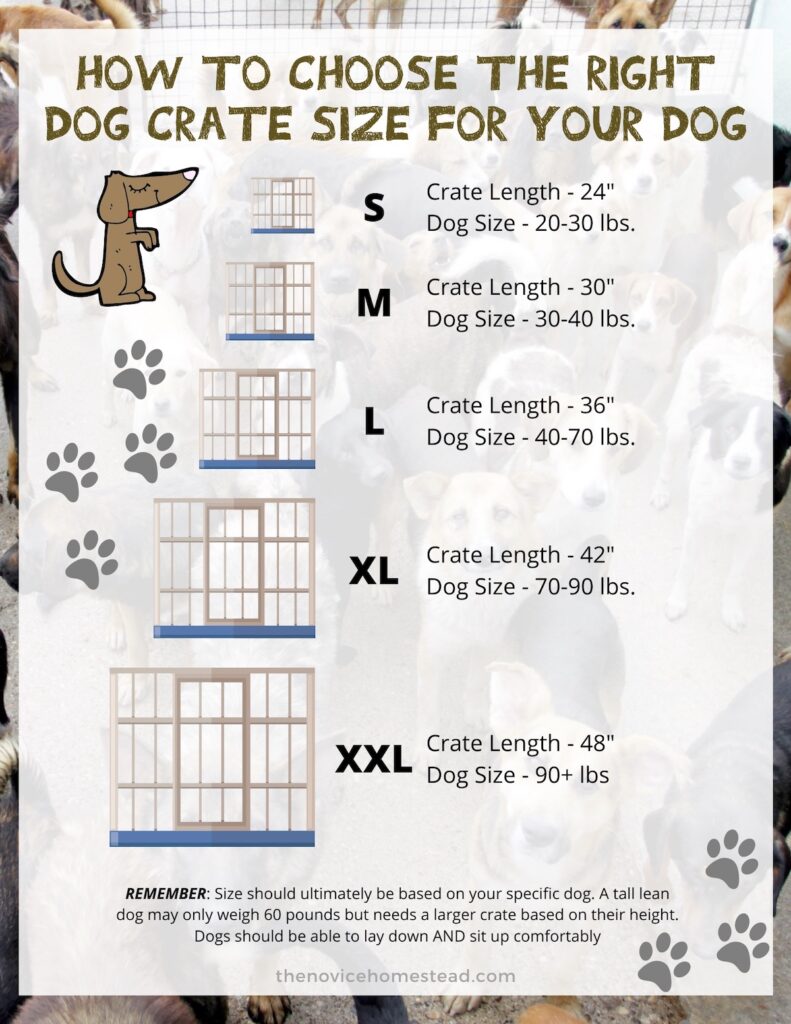
Common Dog Crate Sizes
The following chart is meant as guidance when purchasing a standard size dog crate. Dog crate sizes are usually labeled small, medium, large, etc. or by length in inches.
| Dog Crate Sizes | Crate Length | Dog Size |
| S | 24″ | 20-30lbs |
| M | 30″ | 30-40lbs |
| L | 36″ | 40-70lbs |
| XL | 42″ | 70-90lbs |
| XXL | 48″ | 90lbs+ |
Weight is only one of the considerations for considering dog crate sizes. Your dog’s height and length are also an important factor.
If you have a tall, lean dog, you might go with a larger crate based on their height, rather than weight.
Our dogs both have a 42″ crate, but they only weigh about 60 pounds each. However, we went with the XL size because they are tall and we wanted room for them to sit up comfortably.
TIP: This is the style of dog crate we use — we chose the double door style with a divider. Once the dogs grew fully into their crate, we stopped using the divider.
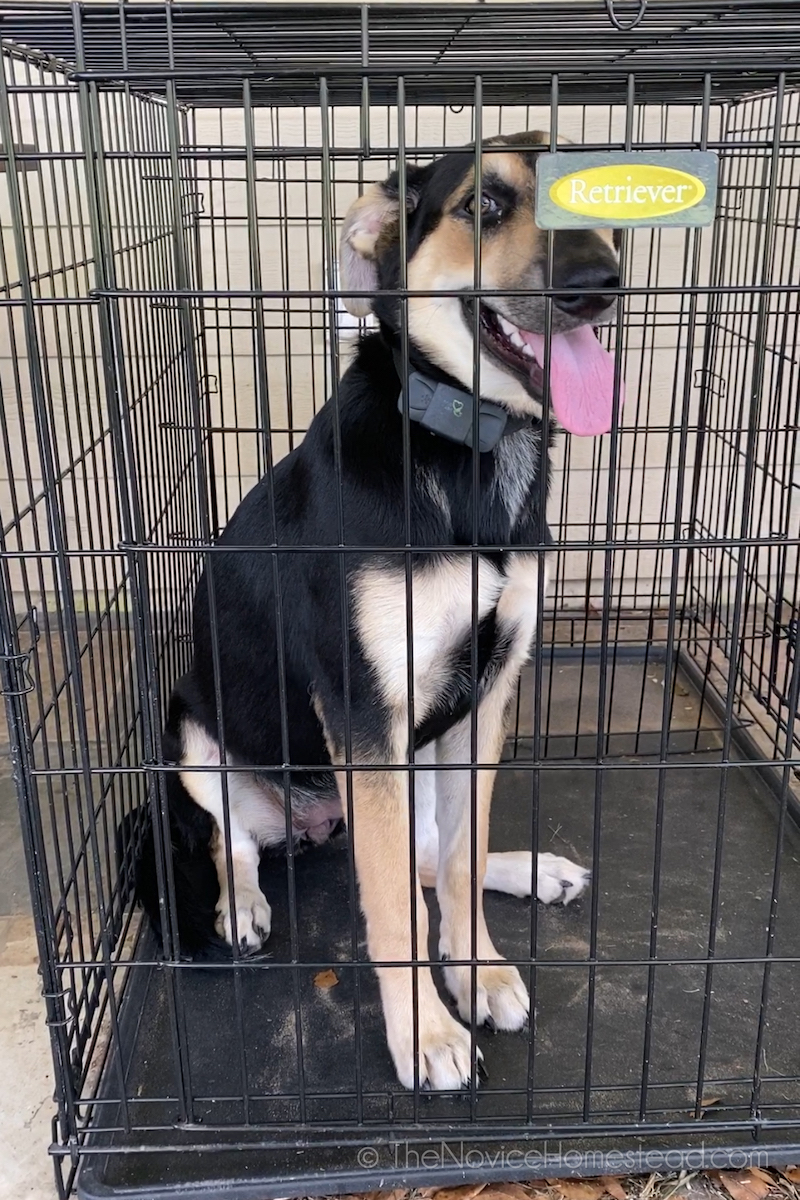
How Big Should a Dog Crate Be?
Bigger is not always better when it comes to a dog crate, especially if you’re still working on potty training.
If a crate is too big, a dog may relieve themselves on one side and go sleep on the other.
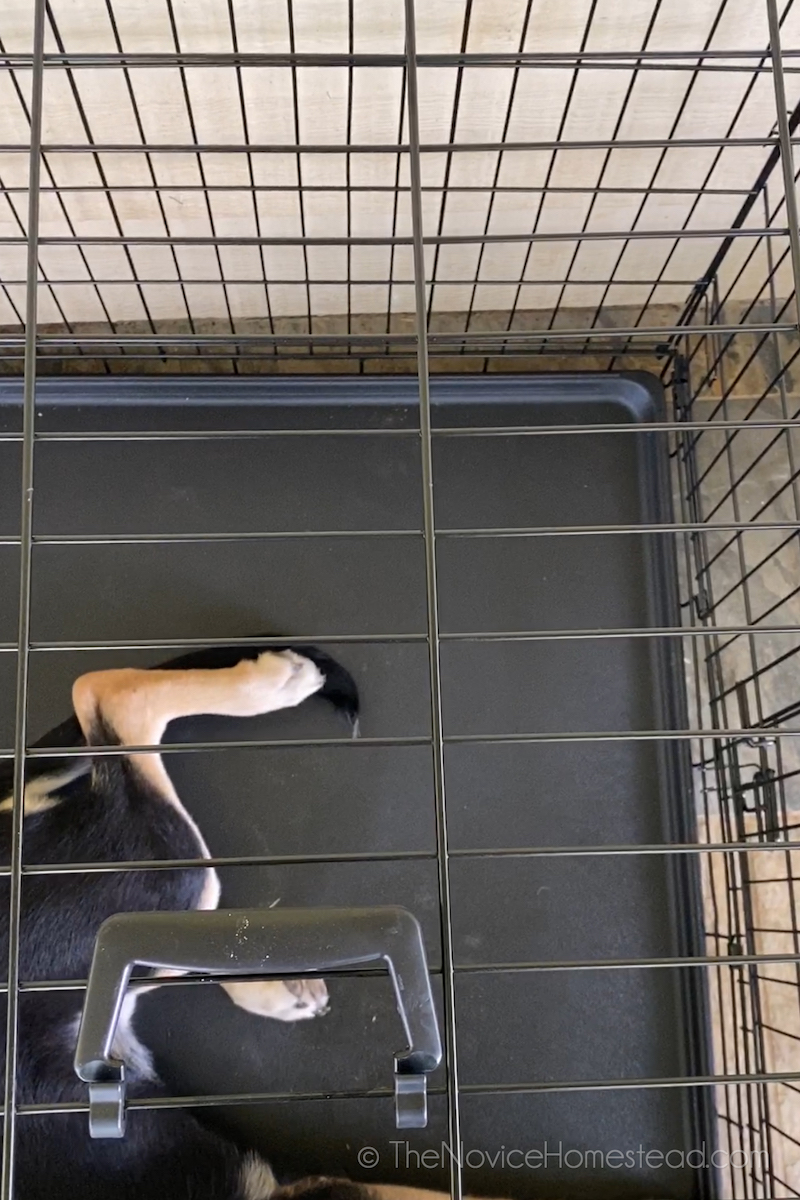
If you are buying a crate for a puppy, I would buy a size up and use a crate divider in the meantime. A divider closes off part of the crate so that it is not too roomy, thus discouraging the dog from using the bathroom inside the crate.
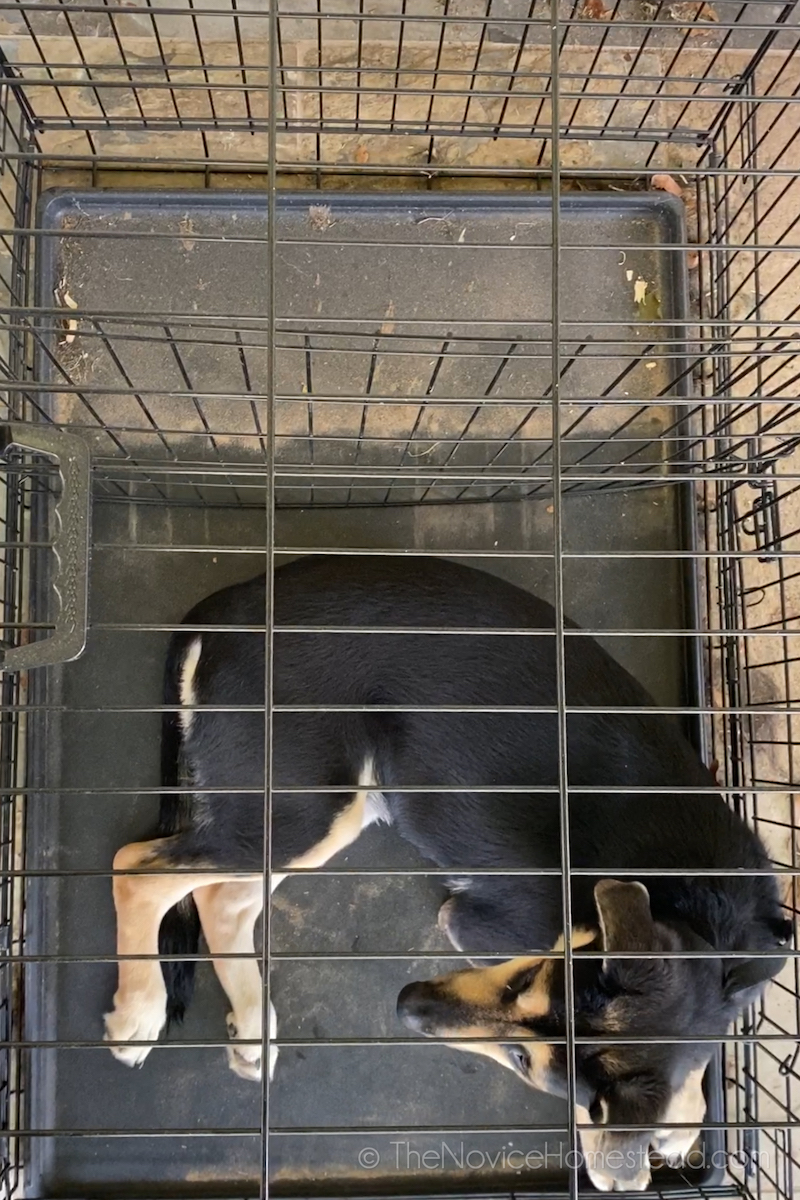
How to Tell if a Dog Crate is Too Small
Dogs like a cozy bed, but you don’t want their crate to be cramped. Dogs need enough room to sit up fully and turn around as needed.
If any of these are true, it’s time to move up a size:
- When sitting, dog has to hunch over or head touches the top of the crate
- Dog can’t comfortable turn around
- Dog is unable to stretch legs out when lying down
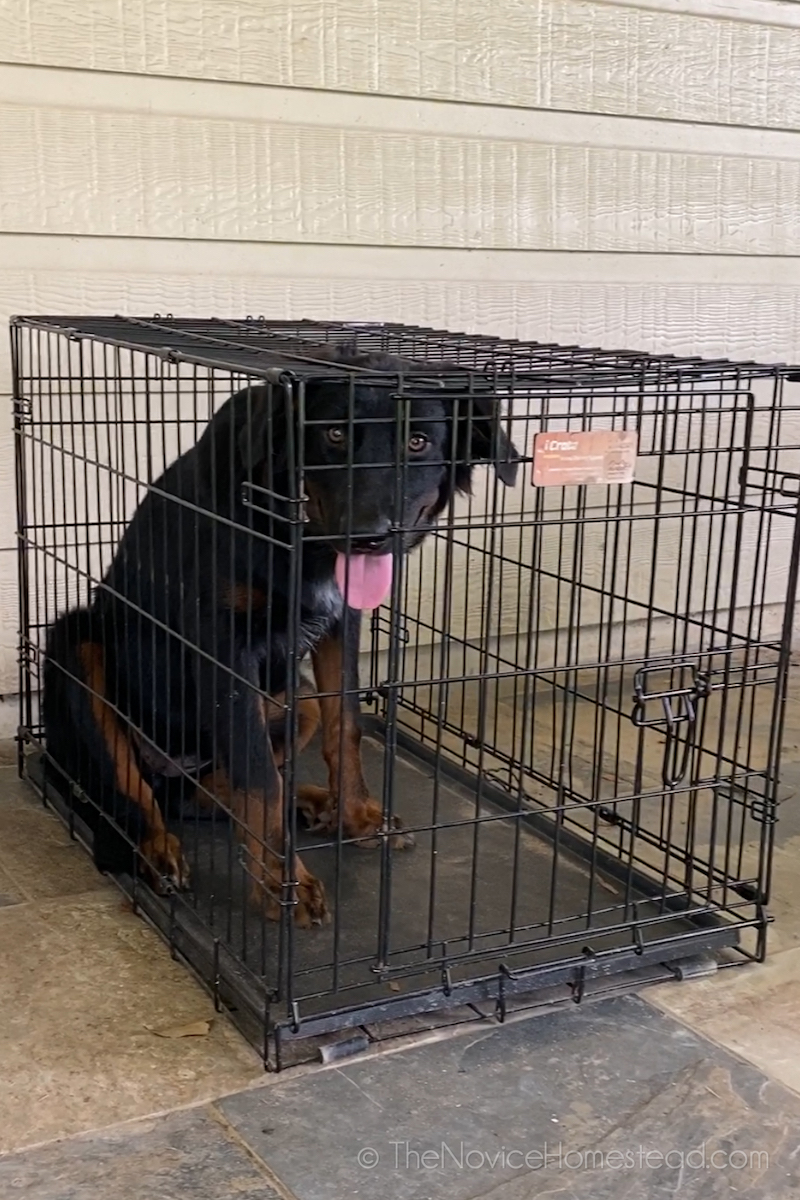
How Crate Training Help with Housebreaking?
When housebreaking a puppy or even an adult dog, a crate is useful because they do not like to soil their sleeping area. A dog will learn to “hold it” until they are able to go outside.
Only one of our dogs has ever pooped in her crate, and that was when I think she ate something outside that upset her stomach. Otherwise they ALWAYS wait until we let them out.
A Crate is a Safety Tool
The other main reason we use our crate is to keep our dogs safe when we can’t supervise them 100%.
For example, when my husband or I mow the lawn, we put the dogs in their crate so they don’t accidentally get in the way.
How Long Can a Dog Stay in a Crate?
Once a dog realizes that a crate is their bed, or “safe” spot, they usually don’t mind going in at all. In fact, our dogs run into their crate at night without even being asked!
Dogs that sleep in their crate at night should be fine for up to 8 hours. The exception being puppies younger than 6 months, who don’t have the ability to hold their bladder that long.
During the day, it’s important to make sure that dogs get exercise and interaction. They should spend no more that a few hours in their crate, and ideally spend most of their time outside of the crate, unless by their choice.
Crating DOs and DON’Ts
- DO make a crate comfortable for a dog, with chew-resistant bedding or a crate mat
- DON’T fill a crate with fluffy bedding and things that a dog is likely to chew and may ingest
- DO provide a safe chew toy for your dog to play with while in the crate
- DON’T leave multiple dogs in a crate together
- DON’T use a crate as punishment, as dogs may grow to resent it instead of viewing it as their safe space
- DO choose a crate size that best fits your dog
- DO choose a crate size that will “grow” with your dog, if buying for a puppy